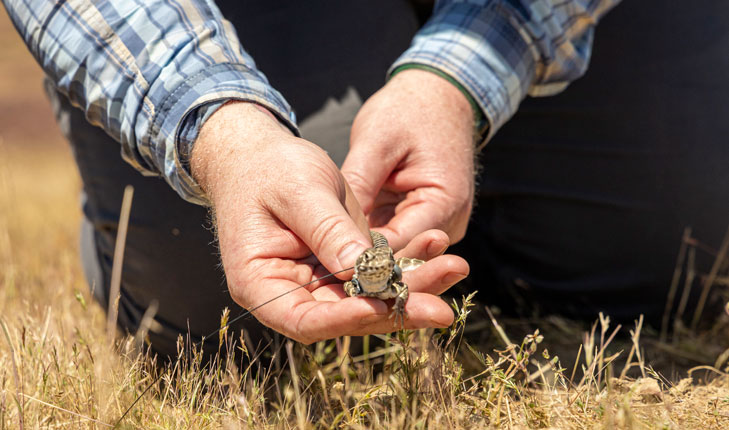Fresno State — in partnership with the Fresno Chaffee Zoo, the Bureau of Land Management, California Department of Fish and Wildlife and U.S. Fish and Wildlife Service — reintroduced 10 blunt-nosed leopard lizards to the Panoche Plateau on May 17.
“This is a great moment for the recovery of the blunt-nosed leopard lizard. In just three years, we went from a dire situation with this population of lizards to a day that gives me hope that the species will thrive in the Panoche Hills,” said Michael Fris, field supervisor of the U.S. Fish and Wildlife Service’s Sacramento Fish and Wildlife Office. “As we celebrate the 50th anniversary of the Endangered Species Act, this effort reflects how species conservation depends on our dedicated partners.”
The group of entities announced their partnership in November 2021 to save the endangered species from extinction.
“Reintroducing endangered blunt-nosed leopard lizards is a major milestone for conservation in the San Joaquin Valley,” said Dr. Rory Telemeco, an assistant professor and herpetologist at Fresno State. “We are proud of the role that Fresno State students and faculty played in making this dream a reality — the research of 10 undergraduate students and three graduate students laid the groundwork for this achievement. We look forward to continued collaboration with Fresno Chaffee Zoo, the U.S. Bureau of Land Management, the California Department of Fish and Wildlife and the U.S. Fish and Wildlife Service to ensure a successful recovery of this unique California species.”
According to Dr. Michael Westphal, acting state ecologist for the Bureau of Land Management, the organization’s Central Coast field office began actively monitoring the blunt-nosed leopard lizard on the Panoche Plateau in 2009. Initial efforts were based on visual monitoring, which was followed by capture and tissue collection for what turned into a groundbreaking, range-wide, genetic survey of the species that showed the Panoche Plateau population to be primordial, small and isolated.
Westphal said “to reduce direct impacts to lizards from handling, and to increase sample size to improve statistical estimation of the population, the [Bureau of Land Management] initiated a project to gather feces using detection dogs, and extract DNA in order to genotype individual lizards. The project resulted in the first successful extraction and sequencing of DNA from wild-collected scat from any reptile species — a result with wider application to reptile conservation above and beyond blunt-nosed leopard lizards. Ongoing scat collection and genotyping began to suggest a decline was happening in the late 2010s.”
In 2019, the Bureau of Land Management partnered with Fresno State and the Fresno Chaffee Zoo to perform intensive surveys, which revealed that only a handful of lizards remained on the Plateau.
“[Bureau of Land Management] immediately initiated negotiations with U.S. Fish and Wildlife Service and California Department of Fish and Wildlife to establish an assurance colony at the Fresno Chaffee Zoo,” Westphal said. “Data collected by [Bureau of Land Management] since 2008 provided a compelling picture of the ongoing decline, and as a result, in July 2020, both agencies issued the crucial permits necessary for the gather to occur.”
Over the past few years, Fresno Chaffee Zoo has maintained the breeding program and collected vital data that improves understanding of the endangered species. The zoo started with five lizards and successfully grew the breeding colony to 60 lizards. After evaluating their health, 10 individuals were identified to be the first group of blunt-nosed leopard lizards to be reintroduced to the Panoche Plateau.
Going forward, the zoo aims to hatch 80 to 100 lizards a year to maintain the breeding colony at the zoo while continuing to release blunt-nosed leopard lizards into the Panoche Plateau until a self-sustaining population is established.
While the zoo worked on the breeding program at its facility, Fresno State students and partnering organizations continued to visit the Panoche Plateau on a regular basis to evaluate the environment and look for any remaining blunt-nosed leopard lizards to collect vital data.
The zoo and partnering organizations will monitor the survival and reproduction of each blunt-nosed leopard lizard that is reintroduced to better understand the requirements for reintroducing the lizards to the San Joaquin desert habitat. The zoo then hopes to use its learnings to create a robust network of populations that can persist.
The zoo also celebrated the groundbreaking of its Conservation Action Center earlier this year, in partnership with the U.S. Fish and Wildlife Service and the Bureau of Reclamation. This new facility will provide guests with the opportunity to see the zoo’s conservation work in action.
“The blunt-nosed leopard lizard breeding program is a catalyst for the zoo’s impact in local conservation work,” said Jon Forrest Dohlin, Fresno Chaffee Zoo CEO and director. “This is a major milestone for the zoo. We have supported several conservation organizations over the years, and now, thanks to our partnerships, and this funding from NSF and the Paul G. Allen Family Foundation, we are poised to become leaders in local conservation science to help save native California species.”
The Conservation Action Center is scheduled to be completed by the end of 2023 and will provide guests with an inside view of the day-to-day operations of the critical care and research it takes to help save the blunt-nosed leopard lizard and serve as the anchor of the zoo’s future conservation initiatives.





